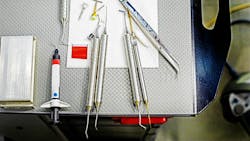Clinical Tips: Selecting hygiene hand instruments
Listen to the article on our podcast!
Choosing the right tools
Dental hygiene has seen some amazing advancements in recent years, especially in plaque biofilm and calculus removal technology. Introducing power instrumentation tools like ultrasonic devices, rubber cup polishing, air polishing, and guided biofilm therapy has helped clinicians better serve their patients' oral health needs-while also alleviating the physical demands related to a heavy reliance on hand instrumentation.
As wonderful as power instrumentation is, hand-activated hygiene instruments will always be needed. Different individuals require different tools and techniques; hand instruments offer a degree of visibility, maneuverability, and tactile sensitivity that power instruments can't always match in certain situations. Although these tools are crucial, many clinicians are intimidated by the idea of selecting hand instruments that best suit their needs. How does one choose? Here are some considerations:
Ergonomics
Research shows that the shape, size, and weight of an instrument have a significant impact on the user's musculoskeletal health.1 It's recommended that hygiene instruments and mirrors have a diameter of at least 10 millimeters and a weight of 15 grams or less. Although it will make the instrument heavier, padding can help decrease the need to pinch and grip the handle.
Function
Hand instruments drastically vary in design; one specific type of instrument can't be used on every tooth of every patient. When choosing what works best for you, it's important to think about the many possible applications such as anterior tooth anatomy, posterior tooth anatomy, supragingival, subgingival, mesial, distal, pocket depth, accessibility, deposit type and tenacity, and so on. Many clinicians have multiple "basic" sets-instruments that are used for most healthy mouths-as well as specialty sets for periodontal patients (area-specific, minis, extended terminal shanks, files).
Material
Hand instruments have traditionally been manufactured with stainless steel because this material is strong and resistant to corrosion. Over the years, alloys containing other metals like carbon, tungsten, and titanium have been introduced and provide increased durability. Certain dental structures, such as implants or porcelain, require hand instruments made of compatible materials like titanium or plastic to avoid damage. Many manufacturers also offer coated, "sharpen-free" instruments that eliminate the need for sharpening in-office.
Variety
It can't be stressed enough that a wide selection of instruments is key to providing individualized patient care. While universal scalers and curettes are wonderful, they have their limits. Accumulating a collection of specialized instruments over time allows a clinician to be prepared for any situation. One might question how often they will realistically use a certain type of instrument and later be surprised at how frequently they do!
The idea of selecting hand instruments can overwhelm and stress out dental hygienists, but it doesn't have to be scary. The secret is to evaluate options based on their ergonomic benefits, function, material, and unique qualities. Peer recommendations help, too. Happy scaling!
References
1. Simmer-Beck M, Branson BG. An evidence-based review of ergonomic features of dental hygiene instruments. Work. 2010;35(4):477-485. doi:10.3233/WOR-2010-0984
About the Author

Bethany Montoya, MBA, RDH
Bethany Montoya, MBA, RDH, is a practicing dental hygienist, educator, industry key opinion leader, and editorial director of DentistryIQ’s Clinical Insights newsletter. She has a passion for advancing modern disease prevention. She specializes in exploring the intersection of clinical practice, professional growth, and innovation within oral health care. Through her writing, she aims to educate, inspire, and spark meaningful dialogue in the dental community. She can be reached at [email protected].

